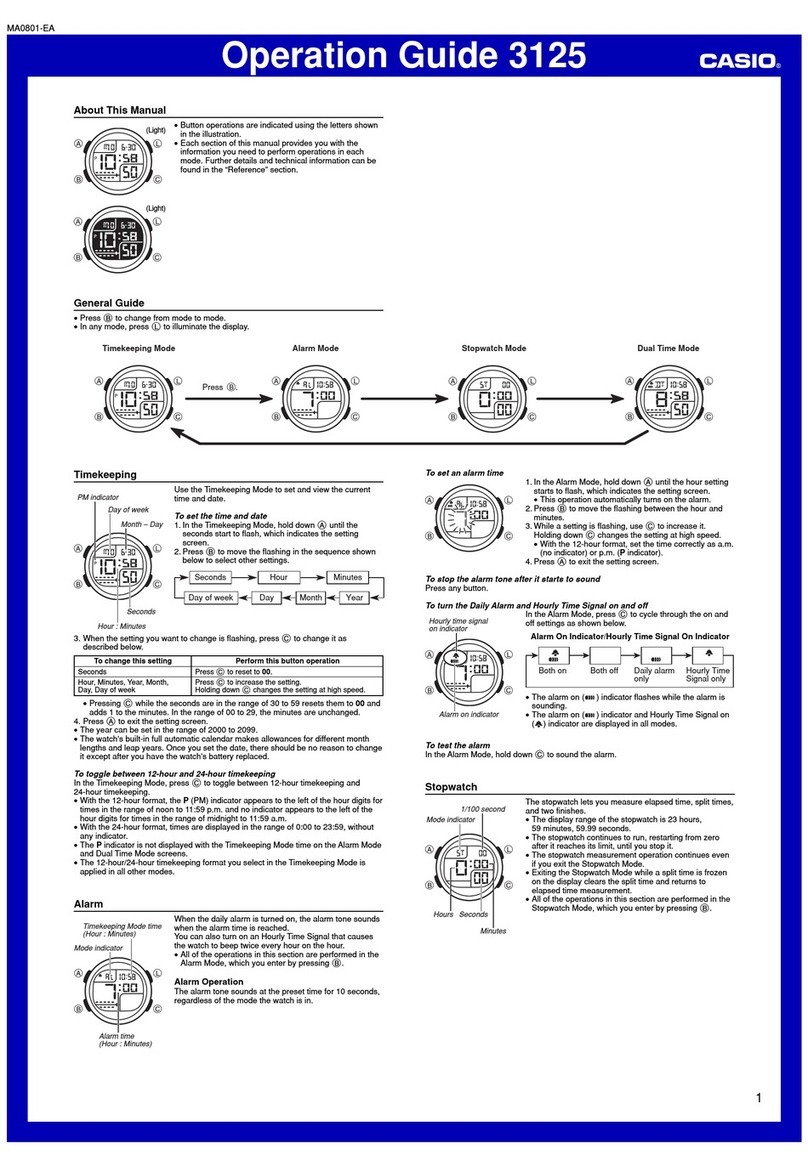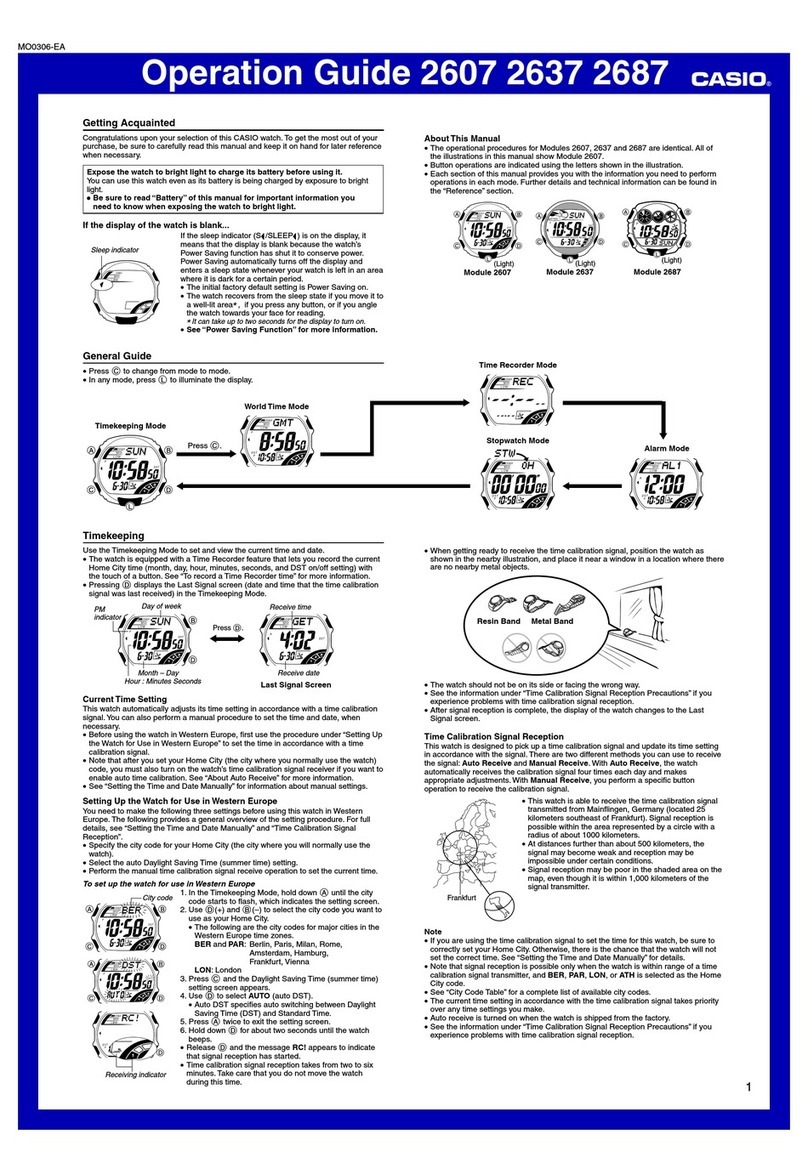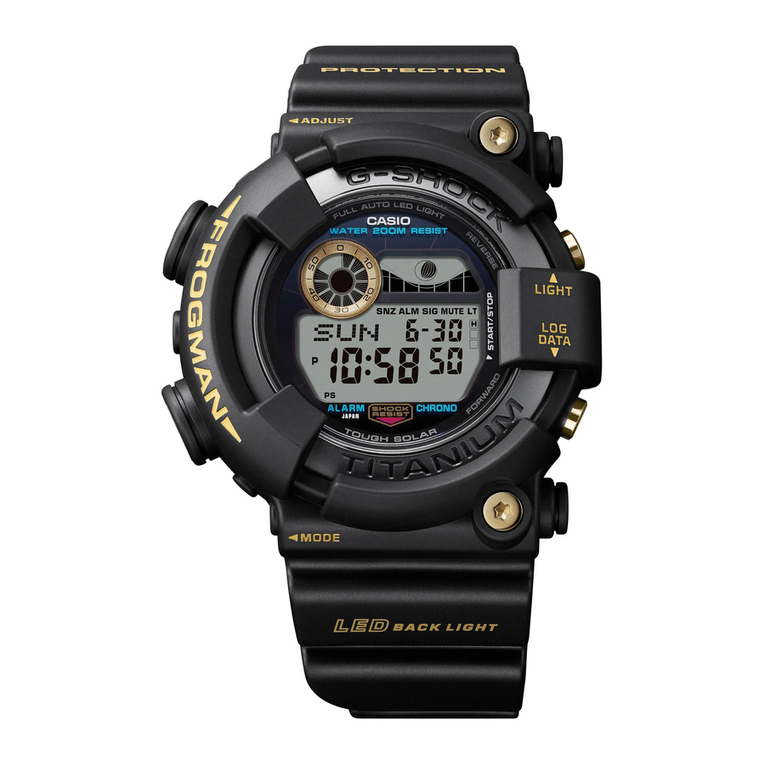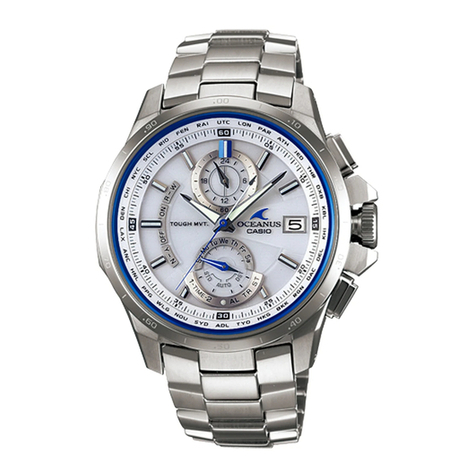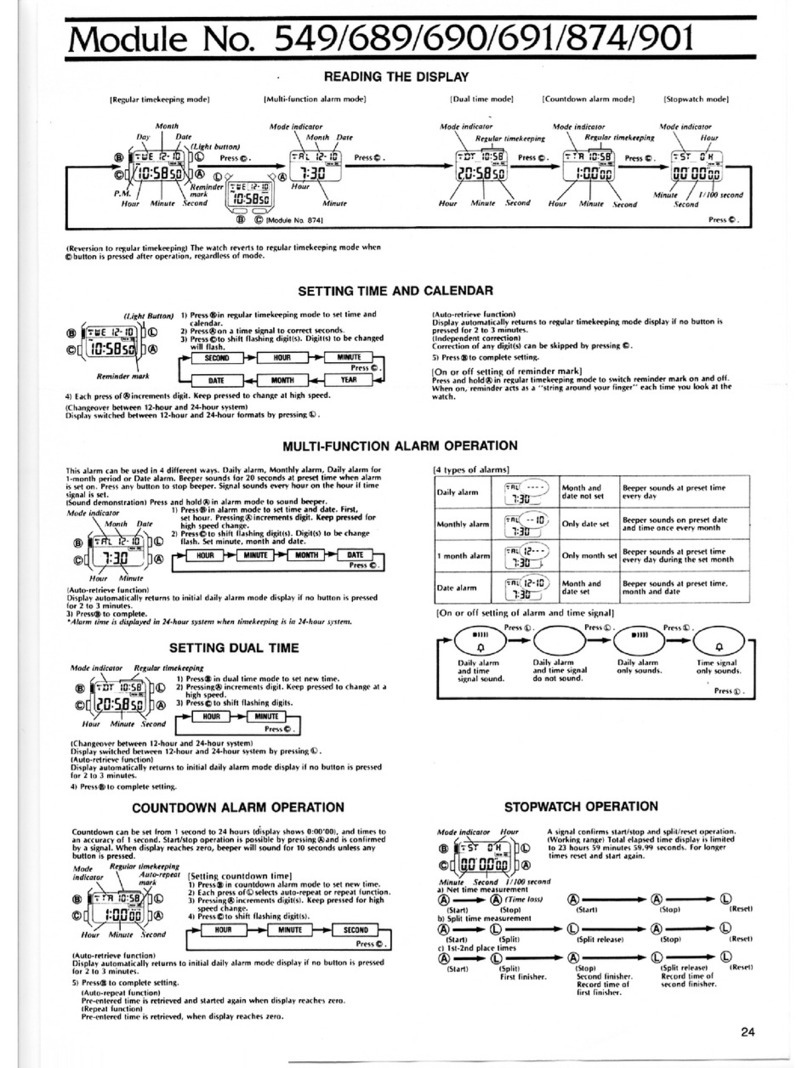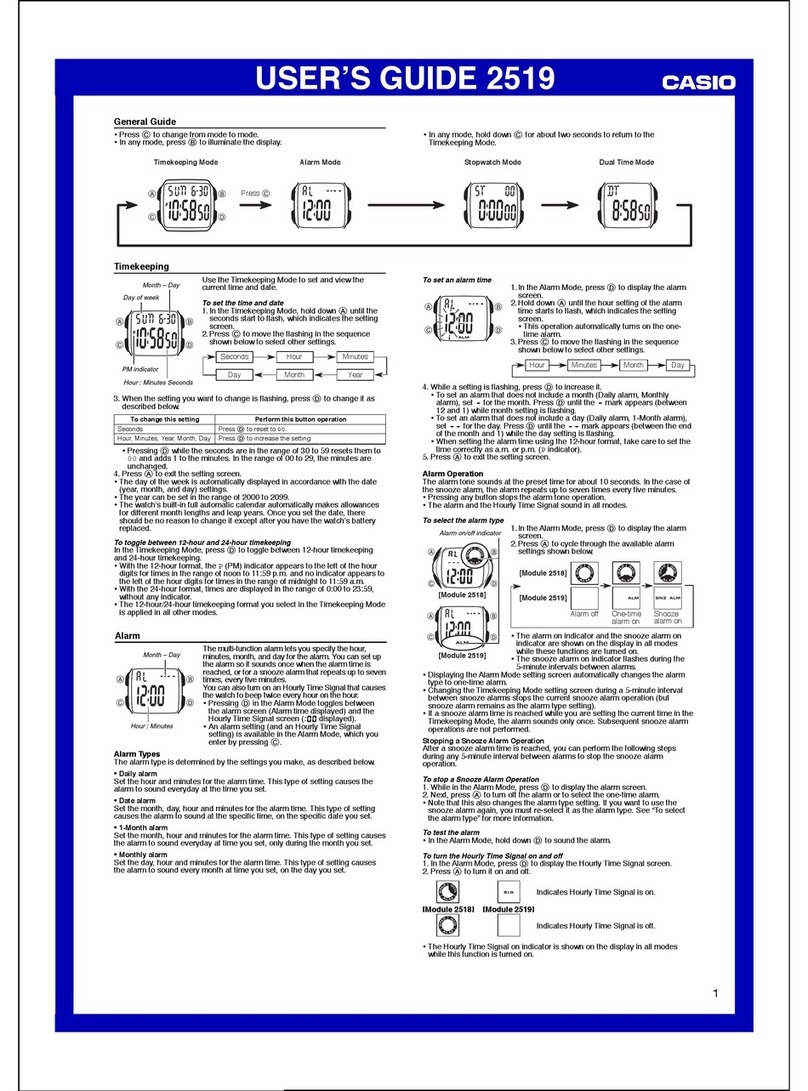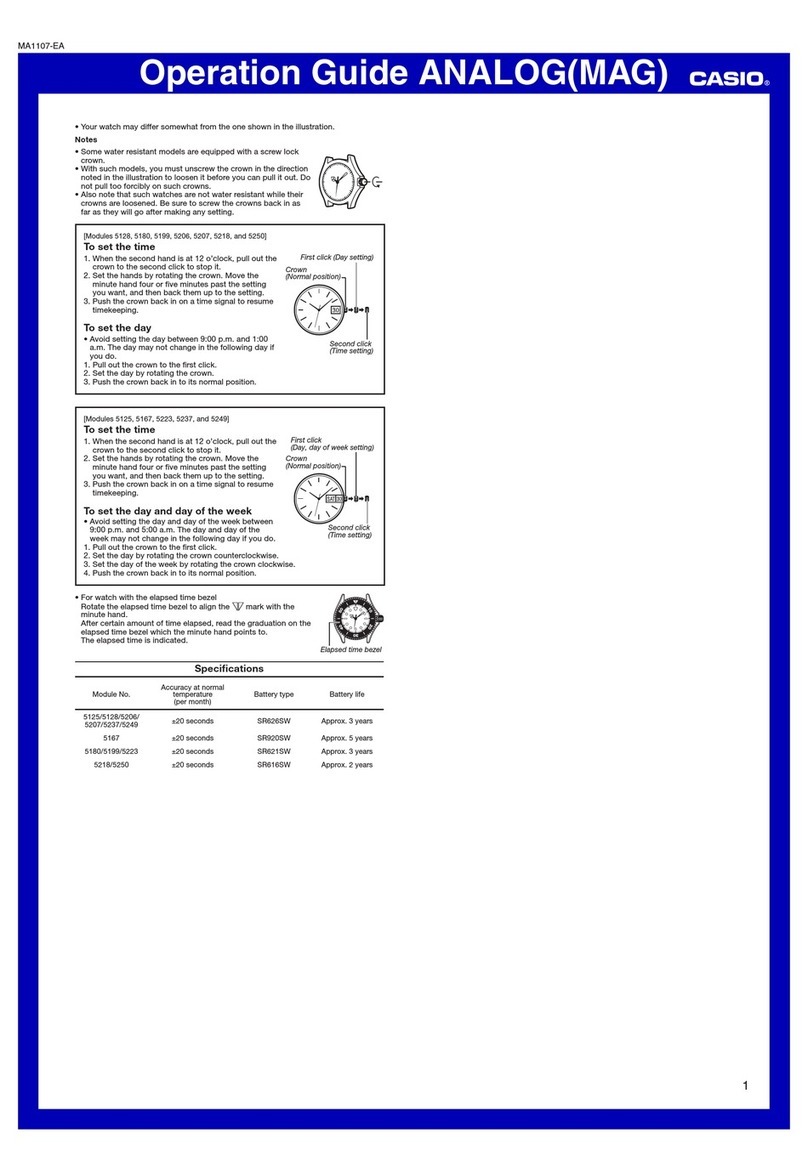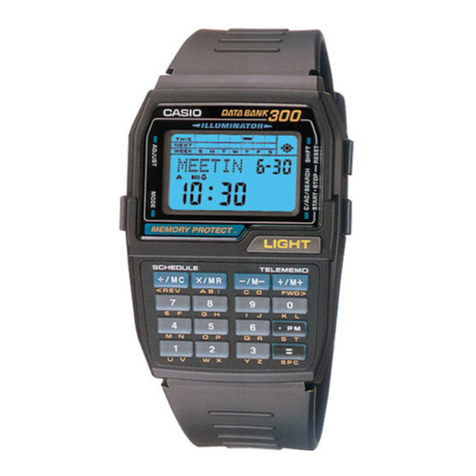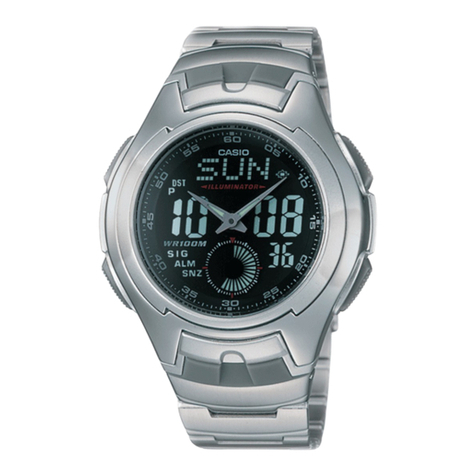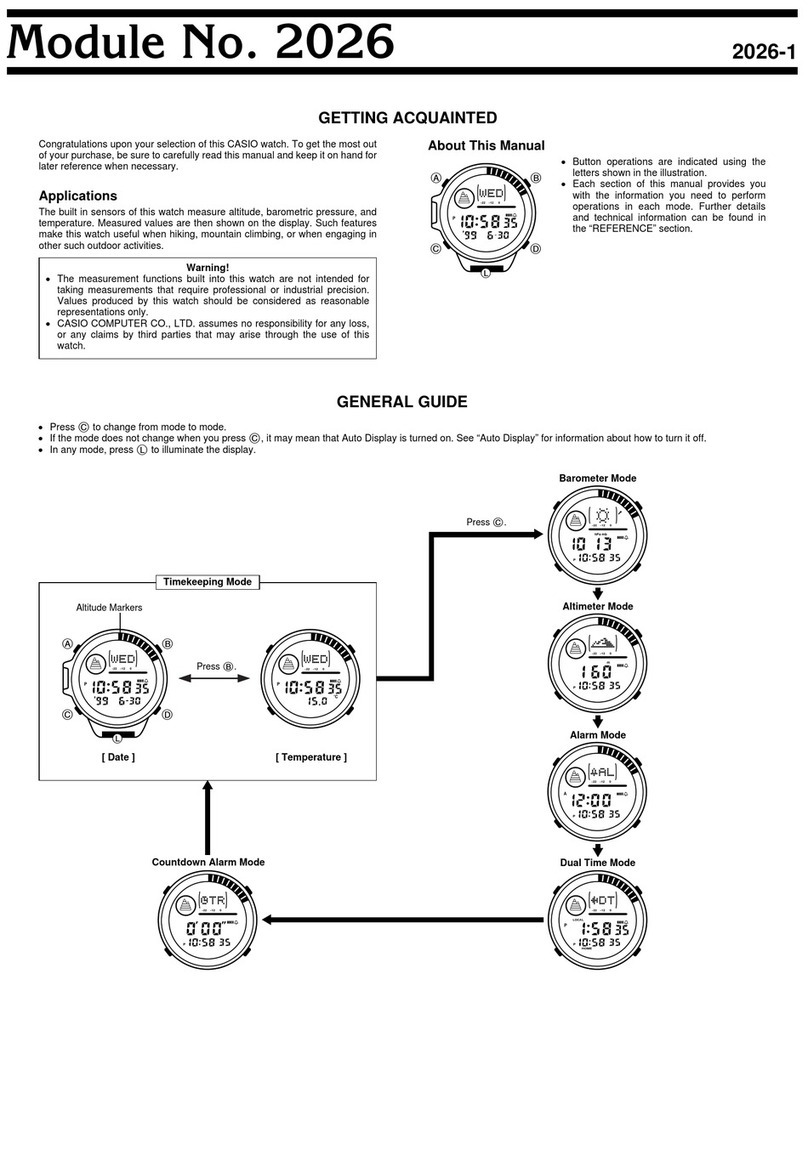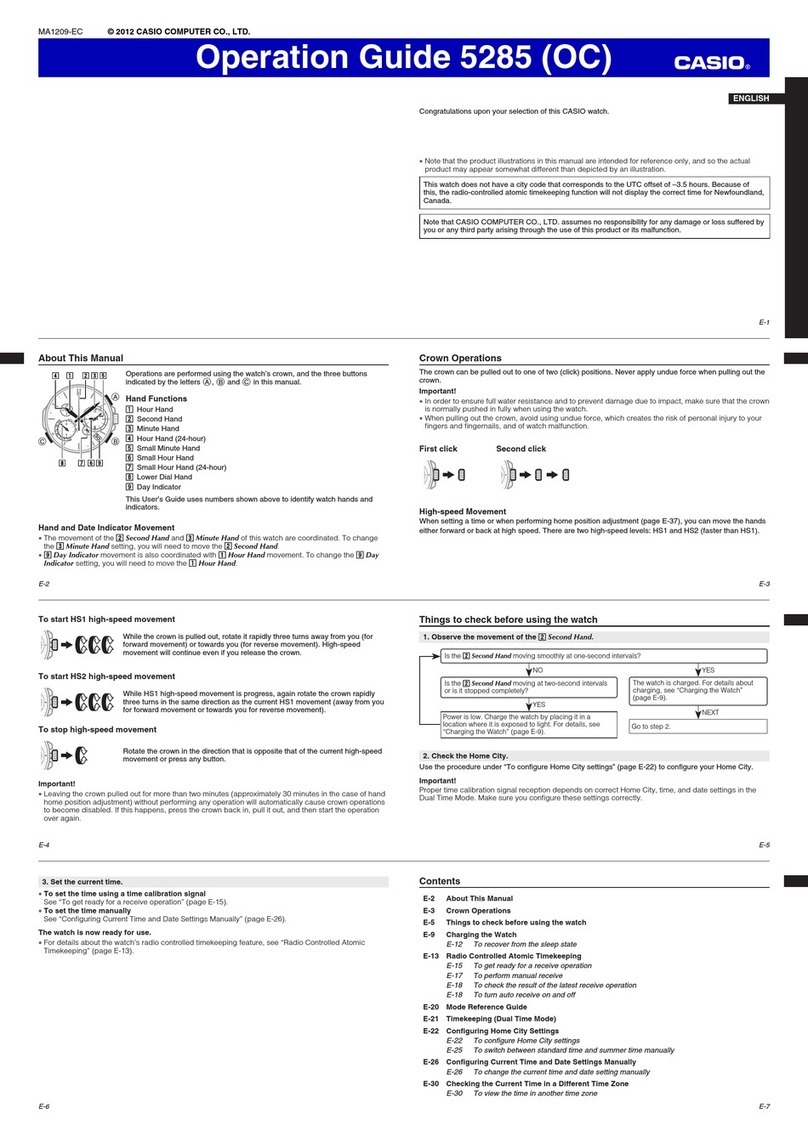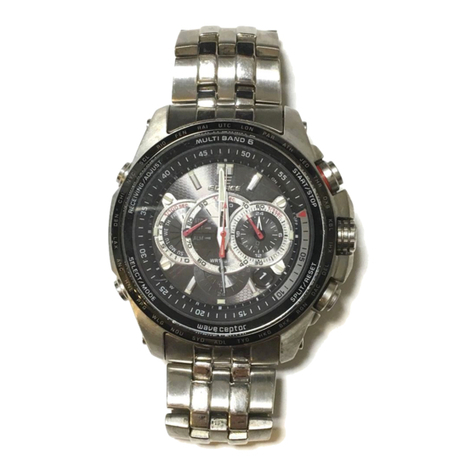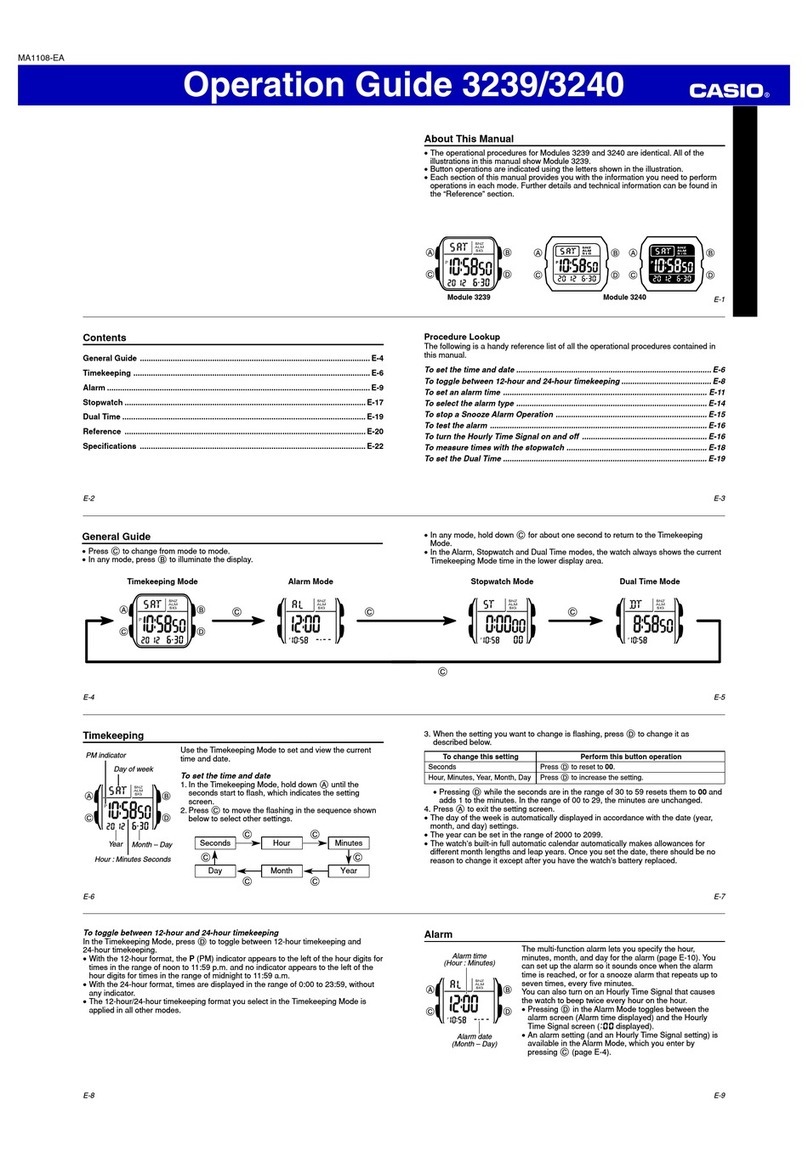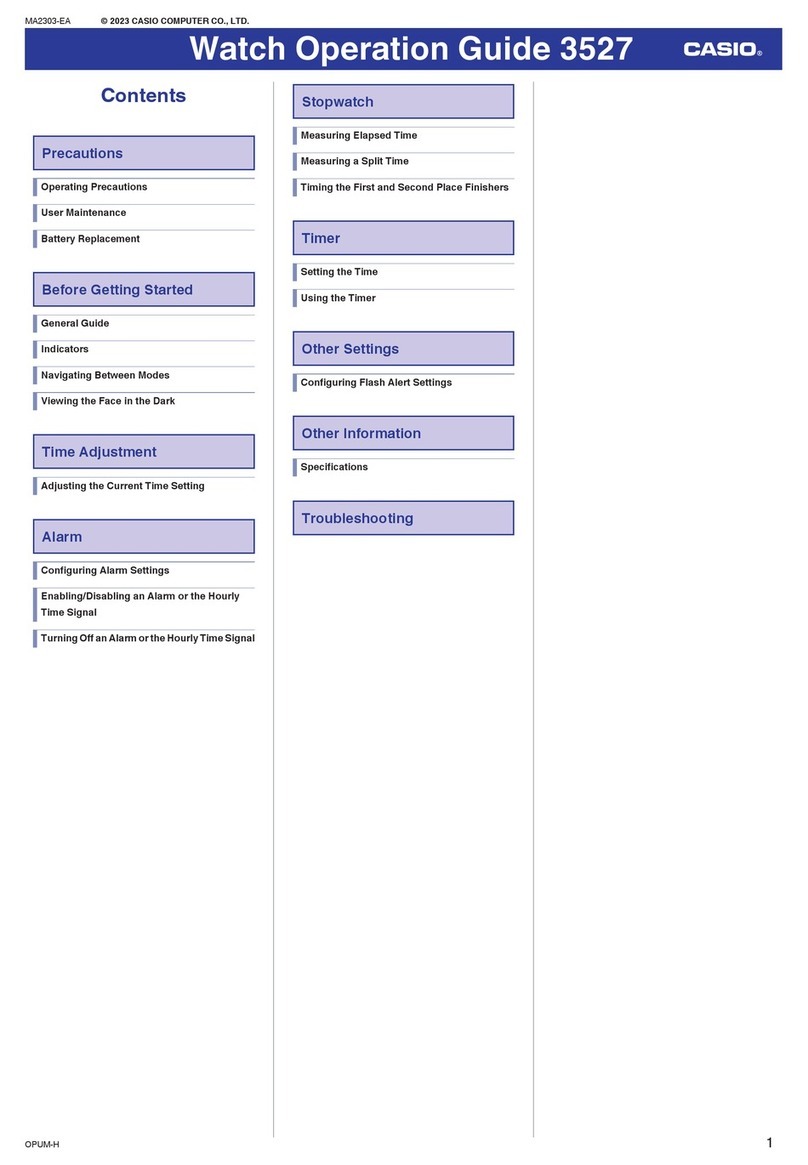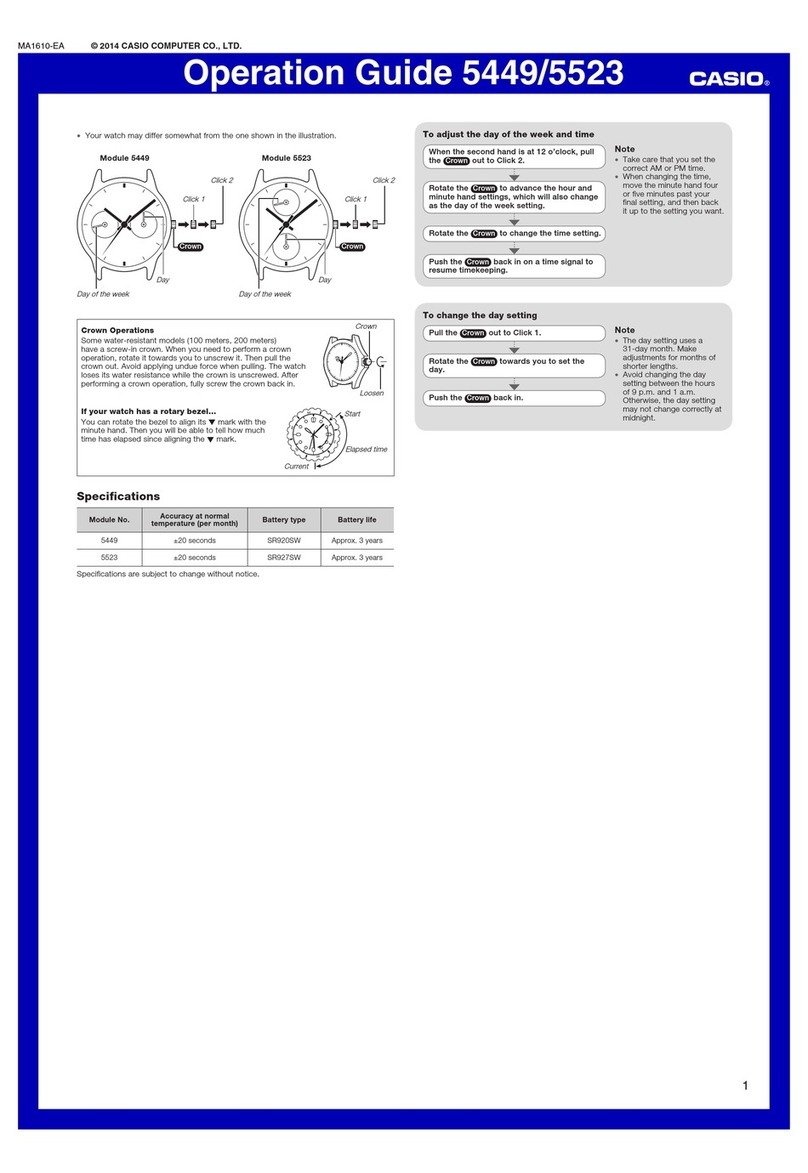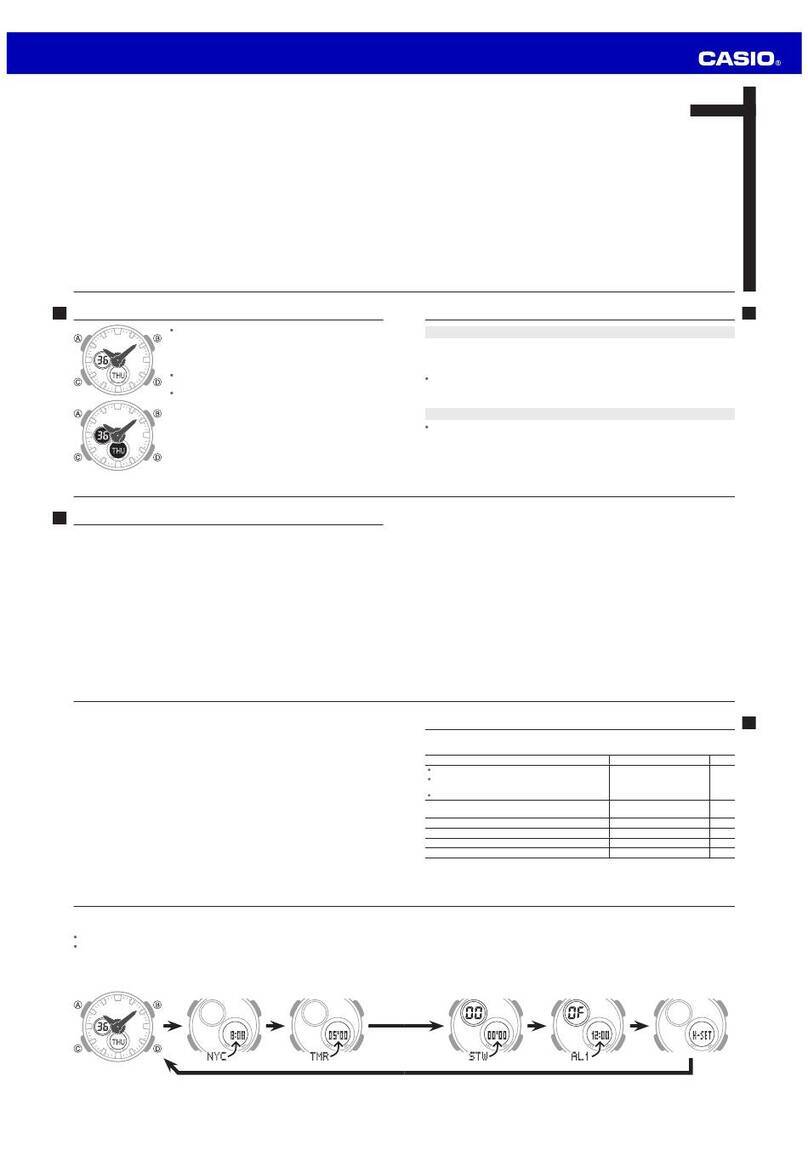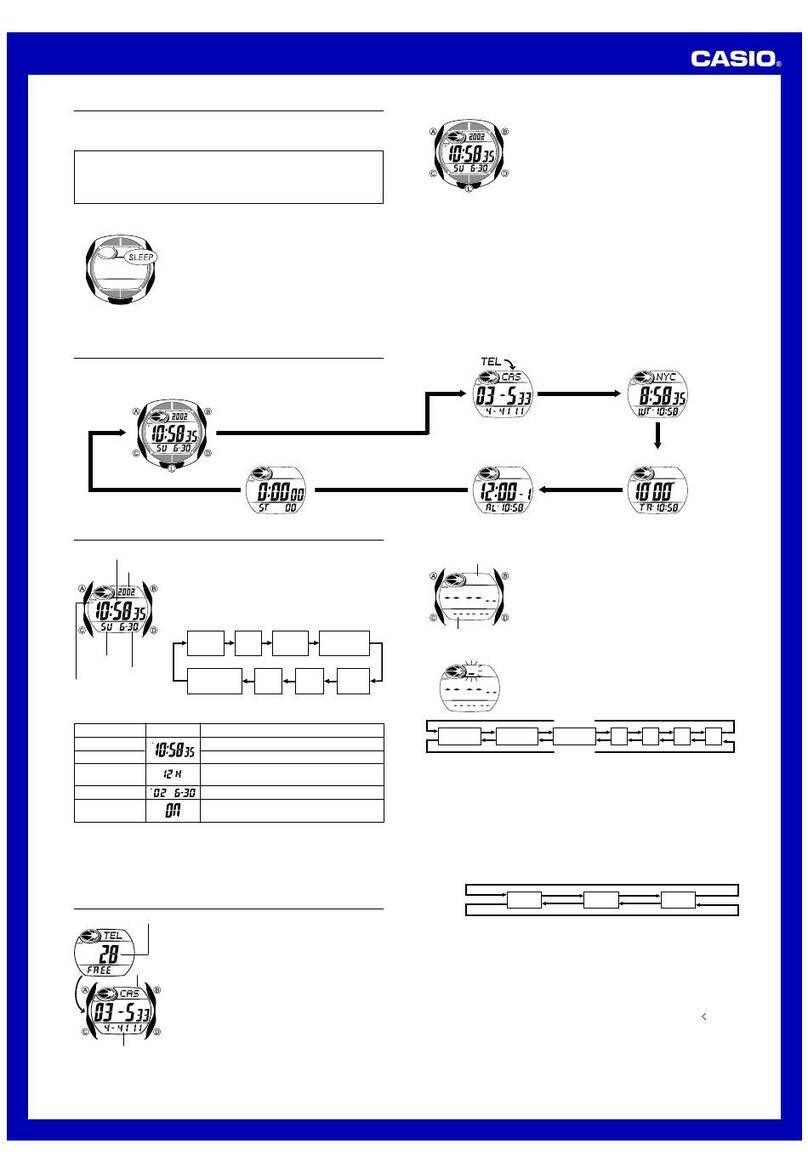
—5 —
Warning!
• Always make sure you are in a safe place whenever you are reading the
display of the watch using the auto light switch. Be especially careful when
running or engaged in any other activity that can result in accident or injury.
Also take care that sudden illumination by the auto light switch does not
surprise or distract others around you.
• When you are wearing the watch, make sure that its auto light switch is turned
off before riding on a bicycle or operating a motorcycle or any other motor
vehicle. Sudden and unintended operation of the auto light switch can create a
distraction, which can result in a traffic accident and serious personal injury.
To turn the auto light switch on and off
In the Timekeeping Mode, hold down Lfor about two seconds to toggle the auto light
switch on ( displayed) or off ( not displayed).
• The auto light switch on indicator ( ) is on the display in all modes while the
auto light switch is turned on.
Battery
This watch is equipped with a solar cell and a rechargeable battery (secondary
battery) that is charged by the electrical power produced by the solar cell. The
illustration shown nearby shows how you should position the watch for charging.
Example: Orient the watch so its face
is pointing at a light source.
• The illustration shows how to position
a watch with a resin band.
• Note that charging efficiency drops
when any part of the solar cell is
blocked by clothing, etc.
• Normally, you should try to keep the
watch outside of your sleeve as much
as possible. Charging is significantly
reduced if the face is only partially
covered.
Solar cell
Important!
• Storing the watch for long periods in an area where there is no light or wearing it in
such a way that it is blocked from exposure to light can cause rechargeable battery
power to run down. Be sure that the watch is normally exposed to bright light
wheneverpossible.
• This watch employs a solar cell that converts light into electricity, which charges a
built-in rechargeable battery. Normally, the rechargeable battery should not need
replacement, but after very long use over a number of years, the rechargeable
battery may lose its ability to achieve a full charge. If you experience problems
getting the rechargeable battery to a full charge, contact your dealer or CASIO
distributor about having the rechargeable battery replaced.
• The rechargeable battery should be replaced with a CASIO-specified CTL1616
battery only. Other rechargeable batteries can cause damage to the watch.
• All data stored in memory is deleted, and the current time and all other settings
return to their initial factory defaults whenever battery power drops to Level 4 and
when you have the battery replaced.
• Turn on the watch’s Power Saving function and keep it in an area normally exposed
to bright light when storing it for long periods. This helps to keep the rechargeable
battery from going dead.
Battery Power Indicator and RECOVER Indicator
The battery power indicator on the display shows you the current status of the
rechargeable battery’s power.
|
|
|
|
|
|
|
|
|
|
|
|
|
|
|
|
|
|
|
|
|
|
|
|
|
|
|
Battery power
indicator
Function Status
All functions enabled.
All functions enabled.
Except for timekeeping and
battery power indicator, all
functions and display indicators
are disabled.
All functions disabled.
Level
1
2
3
4
Battery Power Indicator
(Charge Soon Alert)
|
|
|
|
|
|
|
|
|
|
|
|
|
|
|
|
|
|
|
|
|
|
|
|
RECOVER
indicator
• The flashing CHARGE indicator at Level 3 tells you that battery power is very low,
and that exposure to bright light for charging is required as soon as possible.
• At Level 4, all functions are disabled and settings return to their initial factory
defaults. Functions are enabled once again after the rechargeable battery is
charged, but you need to set the time and date, after the battery reaches Level 3
from Level 4. You will not be able to set any of the other settings until the battery
reaches Level 2 after dropping to Level 4.
• Display indicators reappear as soon as the battery is charged from Level 4 to Level 3.
• Leaving the watch in direct sunlight or some other very strong light source can
cause the battery power indicator to temporarily show a reading that is higher than
the actual battery level. The correct battery power indicator should appear after a
fewminutes.
• If you use the backlight or the alarm a number of times during a short period,
RECOVER appears on the display, and the backlight and beeper tone become
disabled until battery power recovers. After some time, battery power will recover
and RECOVER will disappear, indicating that the above functions are enabled again.
• If RECOVER appears frequently, it probably means that remaining battery power is
low. Leave the watch in bright light to allow it to charge.
Charging Precautions
Certain charging conditions can cause the watch to become very hot. Avoid leaving
the watch in the areas described below whenever charging its rechargeable battery.
Also note that allowing the watch to become very hot can cause its liquid crystal
display to black out. The appearance of the LCD should become normal again when
the watch returns to a lower temperature.
Warning!
Leaving the watch in bright light to charge its rechargeable battery can cause it
to become quite hot. Take care when handling the watch to avoid burn injury.
The watch can become particularly hot when exposed to the following
conditions for long periods.
• On the dashboard of a car parked in direct sunlight
•Too close to an incandescent lamp
• Under direct sunlight
About the Auto Light Switch
Turning on the auto light switch causes the backlight to turn on, whenever you position
your wrist as described below in any mode. Note that this watch features a “Full Auto
EL Light”, so the auto light switch operates only when available light is below a certain
level. It does not turn on the backlight under bright light.
Moving the watch to a position that is parallel to the ground and then tilting it
towards you more than 40 degrees causes the backlight to turn on.
More than
40°
Parallel to
ground
Charging Guide
After a full charge, timekeeping remains enabled for up to about 10 months.
• The following table shows the amount of time the watch needs to be exposed to light
each day in order to generate enough power for normal daily operations.
Exposure Level (Brightness) Approximate
Exposure Time
Outdoor Sunlight (50,000 lux) 5 minutes
Sunlight Through a Window (10,000 lux) 24 minutes
Daylight Through a Window on a Cloudy Day (5,000 lux) 48 minutes
Indoor Fluorescent Lighting (500 lux) 8 hours
• Since these are the specs, we can include all the technical details.
•Watch is not exposed to light
•Internal timekeeping
•Display on 18 hours per day, sleep state 6 hours per day
•1 backlight operation (1.5 seconds) per day
•10 seconds of alarm operation per day
• Stable operation is promoted by frequent charging.
Recovery Times
The table below shows the amount exposure that is required to take the battery from
one level to the next.
• The above exposure time values are all for reference only.Actual required exposure
times depend on lighting conditions.
Exposure Level
(Brightness)
Outdoor Sunlight
(50,000 lux)
Sunlight Through a
Window (10,000 lux)
Daylight Through a
Window on a Cloudy
Day (5,000 lux)
Indoor Fluorescent
Lighting (500 lux)
Approximate Exposure Time
Level 4 Level 3 Level 2 Level 1
2 hours 21 hours 6 hours
6 hours 108 hours 30 hours
9 hours 219 hours 60 hours
103 hours ------------ ------------
▲
▲
▲
Reference
This section contains more detailed and technical information about watch operation.
It also contains important precautions and notes about the various features and
functions of this watch.
Timekeeping
• Resetting the seconds to
00
while the current count is in the range of 30 to 59
causes the minutes to be increased by 1. In the range of 00 to 29, the seconds are
reset to
00
without changing the minutes.
• With the 12-hour format, the
P
(PM) indicator appears on the display for times in the
range of noon to 11:59 p.m. and the
A
(AM) indicator appears for times in the range
of midnight to 11:59 a.m.
• With the 24-hour format, times are displayed in the range of 0:00 to 23:59, without
any indicator.
• The 12-hour/24-hour timekeeping format you select in the Timekeeping Mode is also
applied in all other modes.
• The year can be set in the range of 2000 to 2049. The day of the week is calculated
automatically in accordance with the date you set.
• The watch’s built-in full automatic calendar automatically makes allowances for
different month lengths and leap years. Once you set the date, there should be no
reason to change it except when battery power drops to Level 4.
Auto Return Features
If you leave a screen with flashing digits on the display for two or three minutes without
performing any operation, the watch automatically exits the setting screen.
Scrolling
The A, C, E , and Lbuttons are used in various modes and setting screens to
scroll through data on the display. In most cases, holding down these buttons during a
scroll operation scrolls through the data at high speed.
Power Saving Function
When turned on, the Power Saving function automatically puts the watch into a sleep
state whenever it is left for a certain period in an area where it is dark. The table below
shows how watch functions are affected by the Power Saving function.
• Wearing the watch inside the sleeve of clothing can cause it to enter the sleep state.
• The watch will not enter the sleep state while the Timekeeping Mode time is
between 6:00 AM and 9:59 PM. If the watch is already in the sleep state when the
time reaches 6:00 AM, however, it will remain in the sleep state.
• The watch will not enter the sleep state while it is in the Stopwatch Mode.
Elapsed Time
in Dark
60 to 70 minutes
6 or 7 days
Display
Blank, with
SLEEP flashing
Blank, with
SLEEP not flashing
Operation
Display is off, but all functions are enabled.
All functions are disabled, but timekeeping
is maintained.
